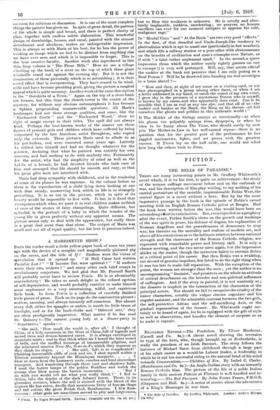MATTHEW MARIS.*
NovNova year ago there passed away in London one of the most remarkable of European artiste, Matthew Marie, a Dutchman of Bohemian. descent. He had lived in England for many years, but under conditions of such complete seclusion that few, even among picture-lovers, realized that this painter was in our midst. Hardly ever was a picture of his to be.seen publicly, and to most people he was. known only by reproductions and by reputation. When a few years ago a picture by Maria unobtrusively made its appearance on the walls of the National Gallery, no surprise at the presence of a work by a living painter was felt, for this little canvas took its place authoritatively as a masterpiece. Reserved and austere to the last degree, this picture of Amsterdam leaves • .3.fatthele Marts; a Soarer*. Arranged by D. crest Thomson. London Wallis and Son. fel Is. neti no room for criticism or discussion. It is one of the most complete things the painter has given us. In spite of great detail, the pattern of the whole is simple and broad, and there is perfect clarity of plan, together with endless subtle elaboration. This wonderful Design of drawbridge, houses, and canal, painted with the utmost detachment and aloofness, makes an unforgettable impression. This is always so with Maris at his best, for he has the power of evoking an image which we feel to be distinct from anything else we have ever seen and which it is impossible to forget. This is the true creative faculty. Another work also reproduced in this thin limp volume is " The Flour Mills." Here we see a village climbing up the bank of a river on the top of which three giant windmills stand out against the evening sky. But it is not the domination of these pictorially which is so astonishing ; it is their moral effect that is overpowering. They have ceased to be wind- mills and have become presiding genii, giving tho picture a magical appeal which is quite uncanny. Another work of the same description is the " Outskirts of a Town." Again on the top of a river-bank are houses, but this time the church-tower is the centre of the mystery, for without any obvious metamorphosis it has become a Sphinx propounding unanswerable questions. All Maris's landscapes had not these strange qualities, and some, like the
Enchanted Castle " and the •` Enchanted Wood," show no signs of magic except in their titles. The spell did not always !incl. Perhaps the best-known works of the master are those figures of peasant girls and children which have suffered by being vulgarized by the late American artist Broughton, who copied only the externals. These pictures Maris used to allude to as his pot-boilers, and were executed many years ago. Latterly Lc retired into himself and had no thought whatever for the morrow, declaring that what he painted was entirely his own concern, and had nothing to do with anybody else. Fortunately for the artist, who had the simplicity of mind as well as the baits of a hermit, he had devoted friends who took care of him, and arranged that life should be smooth and easy, so that his great gifts were not interfered with.
Maris had deep sympathy with childhood, and in the rendering of some of its phases ho was supreme. In the volume before us there is the reproduction of a child lying down looking at one with that steady, unswerving look which in life is so strangely perturbing. It is so too in the picture, which in spite of its beauty would be impossible to live with. It has in it fixed that etrangenesswhich when we meet it in real children makes usthink at once of the stories of fairy changelings. Quite different, but splendid, is the portrait of a baby in which the wonder of the young life is given perfectly without any apparent means. The picture seems only to deal with the appearance, but really there is a great deal more than that alone. The output of Maris was small and not all of equal quality, but his best is precious indeed.











































 Previous page
Previous page